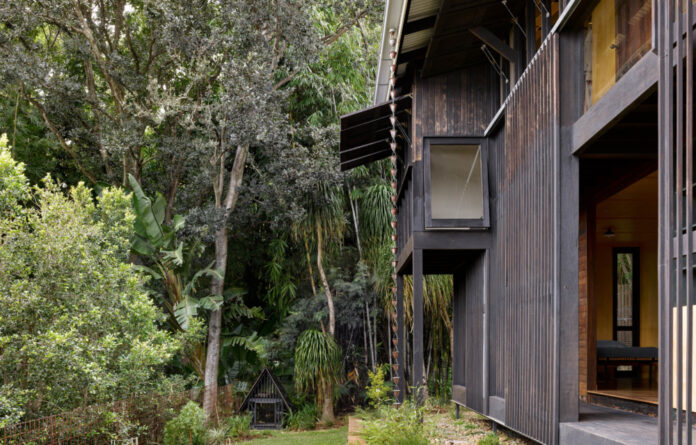[ad_1]
A Clever Brisbane Family Home Inspired By Japanese Architecture
Architecture

Narrow House is located in Red Hill, Brisbane.

Vokes and Peters designed a renovation that extended the late 1800s, early 1900s workers’ cottage.

The design makes the most of the narrow block’s lush garden.

The house is now home to the owner-builder, his partner, and their young daughter.

The owners elected to char the hardwood frame and cladding elements using the traditional method to preserve the timber.

A central living space. Low table made from recycled concrete and steel reo by Clare Kennedy.

The ‘resilient’ floor planning of the timber Brisbane cottage allows each space’s purpose to be determined by the owners as their needs change over time.

A new kitchen was created in the existing part of the house.

The rooms also feature a wood workshop and a design studio.

Playful hints of of colour come through in the vanity benchtop made waste concrete by Clare Kennedy.

The design also ensured natural light throughout the narrow floorplan.

A look into the sweeping ceilings on the second floor.

Windows also offer natural breeze.

The house brings the outside into the calming interiors.

A simple bedroom upstairs.
This unique Brisbane home took almost 10 years to become the warm and inviting house it is today.
The owner of the two-bedroom workers’ cottage wanted to embrace the block’s narrow site and make the most of its rear garden, engaging architects Vokes and Peters for the renovation that he would build himself.
Unlike most architectural projects, which often evolve from the client’s needs and wants, his only request was that the home was to be built ‘in anticipation of a life he didn’t yet lead’ — even if he didn’t quite know what that might be.
‘When we commenced the project with Jack he didn’t have a specific design brief so we decided to arrange the floor plan to enable flexibility, future-proofing and agility to adapt to life changes and demands,’ Vokes and Peters co-founder Stuart Vokes says.
They drew inspiration for this from the architecture of traditional Japanese ‘Machiya’ houses; a townhouse built on similarly narrow blocks with small street frontage. These builds were created around central gardens to ensure natural light and ventilation flows throughout the home, with different sized rooms and adjustable sliding dividing walls called shoji screens.
The resulting extension was designed as a suite of ‘un-programmed’ rooms – small, medium and large in size – with a laundry and a bathroom, arranged over two storeys alongside a soaring double-stacked verandah. Stuart adds that each space feels like ‘living in a garden’, enhanced by the charred hardwood timber frame, timber floorboards and natural materials throughout.
It took a series of stages, stops and starts and almost a decade for Jack to complete the build. But the open-ended design has allowed the home to become the perfect place for Jack and his partner Clare, an architect and founder of Five Mile Radius, to raise their young daughter.
‘All we did was locate the kitchen at the point that we thought was critical in the plan: in the old house between the street and the backyard,’ he notes.
Now, the flexible, un-programmed rooms are now occupied as bedrooms, a wood workshop and a design studio, bringing new meaning to the interiors with with the help of furniture, art and objects.
‘Jack and Clare have been ‘discovering’ how they can best occupy the building,’ Stuart says. ‘The rooms are slowly being programmed with specific functions.’
[ad_2]
thedesignfiles.wpenginepowered.com










